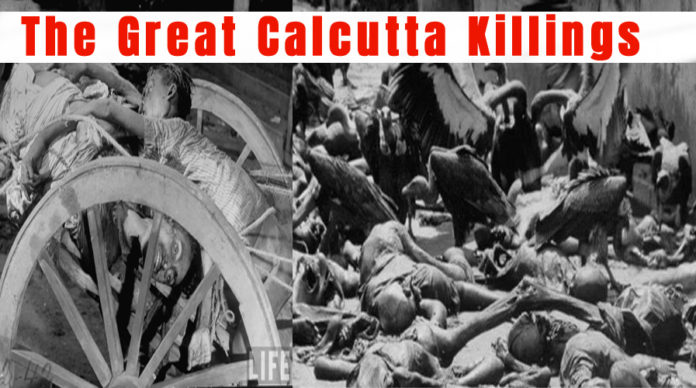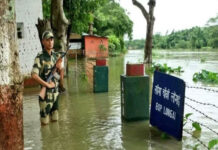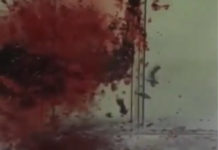16th August, 1946- As we complete 75 years of one of the most ghastly episodes of India’s and Bengal’s history, the current sociopolitical scenario of Bengal makes it imperative for all of us to revisit those dark days to find an answer to similar such issues cropping up at present.
The Indian National Congress and the Muslim League were the two largest political parties in India in the 1940s. The Muslim League, in it’s Lahore Convention in 1940 had adopted a resolution that it would raise the demand that the Muslim majority areas of India in the northwest and the east be constituted as ‘independent states’. The 1946 3-member Cabinet Mission to India headed by Strafford Cripps, for planning of the transfer of power from the British Raj to the Indian leadership proposed a three-tier structure: a centre, groups of provinces, and provinces. The “groups of provinces” were meant to accommodate the Muslim League’s demand. Both the Muslim League and Congress in principle accepted the Cabinet Mission’s plan. However, Muslim League did not have faith in the Congress’s acceptance of the demand.
Giving vent to the fear of the Muslim League, it’s leader, ex Congressman, Md. Ali Jinnah called a Press Conference at his Mumbai residence in July, 1946 to announce that the Muslim League had chalked out a plan to launch a struggle for achieving their demand of an independent state. ‘We will either have a divided India or a destroyed India’, Jinnah stated. One of the first steps towards the said struggle was calling of a General Strike (hartal) on 16th August, 1946 and termed it as ‘Direct Action Day’. 16th August was cleverly chosen by Jinnah as that year it was the 18th day of Ramzan, the day the Prophet Muhammad waged the fierce Battle of Badr, defeating the Non Believers and conquering Mecca. Hence it was a significant day for the Islamists and was an indirect call by Jinnah to repeat their ‘triumph’ over the heathens. This call in itself established Jinnah as a bigot, far removed from the polished, elitist image he used to carry earlier on.
Undivided Bengal, at that time was the only state, which was ruled by the Muslim League led by Husseyn Shaheed Suhrawardy, the Prime Minister of Bengal. The Muslim League had been strengthened when the ex Chief Minister of Bengal, A. K Fazlul Haque joined it’s ranks as the latter’s Krishak Praja Party failed to garner majority support of the people of Bengal. This could have been averted had the Congress supported the KPP, as was proposed by Dr. Shyama Prasad Mukherjee. Some Bengal Congress leaders were also not averse to the above idea. But the Congress Central Leadership was adamant in their stand of not lending support to Haque’s KPP- a decision which spelt disaster for Bengal subsequently with the Muslim League emerging as the most powerful political party there.
Backdrop – The seeds of discontent had already been sown amongst the Hindu and Muslim populations of Bengal when the British colonial rulers headed by Lord Curzon partitioned Bengal in 1905. Though both the communities fought together to re- unite Bengal and was finally successful in nullifying the partition in 1911, the British had succeeded in driving a wedge between the two communities by pushing forth the narrative into the minds of the Muslim populace that the partition would help them economically. The tension between the two communities had heightened between 11-14 February 1946 with riots and communal clashes in Calcutta. Both the Hindu and Muslim newspapers at that time added fuel to the fire through inflammatory and highly partisan reporting, thus increasing the antagonism between the two communities.
Suhrawardy’s plan– The Prime Minister of Bengal, H.S. Suhrawardy decided to use the above-mentioned communal differences to his advantage to realize his sinister plan of merging the entire Bengal with Pakistan, as desired by Jinnah too. His plan was to eliminate the Hindu population of Calcutta and it’s outskirts- Howrah, Hooghly and the two 24 Parganas, either by killing them or by forcing them to flee out of fear of being killed. Undivided Bengal at that time was Muslim majority state with 42% Hindus. Calcutta, however was a Hindu majority city with 64% (12.8 lakhs) Hindus and 33% Muslims (6.6 lakhs) out of a total of 20 lakh people living in the city. The only way to free Calcutta and it’s adjoining areas of Hindus was by killing them, which would instil fear in the minds of the rest of the others, thus forcing them to flee because it is believed that killing 100 people would trigger an exodus of at least 4000 people. That is the mathematics and the psychology of terrorism.
Suhrawardy had planned to bring in Muslims, around four lakhs of them from in and around Kolkata, primarily from the Muslims majority areas the densely populated eastern part of Bengal and get them to settle down there after taking over the properties left behind by the escaping Hindus. Calcutta and it’s adjoining districts were rich and industrially advanced. Hence Suhrawardy believed that the inclusion of these areas as a part of Bengal which would form part of Pakistan would substantially help the state economically.
Besides, Suhrawardy apparently had a substantial number of unnamed property in his favour, the transfer/sale of which would have been difficult, given their shady nature. Hence he was so desperate to retain Calcutta as a part of his proposed Bengal empire which he intended to merge with Pakistan.
Precursor to the Calcutta Killings – Suhrawardy very cleverly went about creating a favourable environment around him which would help in his Hindu massacre plan. The first step he took was to replace the Bihari Hindus in the city’s police force with Pathans and Muslims from the United Provinces (present day Uttar Pradesh). The hindu police constables from Aarah, Balia, Chapra and Deoria were devout hindus, devotees of Bhagwan Ram and Hanumanji. They would have been an obstacle in the path of Hindu massacre. Hence, the notorious ICS officer, Niaz Muhammad Khan was roped in to recruit the Punjabi Muslim and Pathan constables. These police personnel, who were extremely ferocious and merciless by nature went on to help the Muslim Leagues cahouts in killing, rape and torture of the Hindus. One such instance of their display of barbarism was the mass rape of Hindu nurses staying in a hostel in Harrison Road (currently M. G. Road) Central Calcutta. This incident was a warning bell for the Hindu populace of Bengal.
Run up to the Direct Action Day– R. L. Walker, the Chief Secretary of Bengal in 1946 advised Suhrawardy to request for a public holiday on the 16th of August since the former feared picketing and conflicts on that day, which would be minimized if govt. offices and commercial establishments remain closed on that day. Suhrawardy requested the Governor of Bengal, Sir Frederick Burrows to declare 16th August as a public holiday. However, Congress was opposed to the idea as declaration of a public holiday would automatically imply that their members too would have to shut shop and would be compelled to lend support to the League’s hartal. Besides, a holiday would enable those who are idle to successfully enforce the bandh even in areas where the League was not so strong. The Congress accused the Muslim League of communal politics. On August 14, Congress leader in the Bengal Legislative Assembly, Kiran Shankar Roy urged upon Hindu shopkeepers to keep their shops open in defiance of the hartal. Congress’s monopoly over the call for hartals appeared to be shaken. However, later we found the same Kiran Shankar Roy was in favour of Suhrawardy’s claim for Greater Bengal.
That the Hindu massacre was pre-planned was also evident from the reports of British police and Intelligence Officers which stated that special coupons for gallons of petrol were issued in the name of the Muslim League leaders and this petrol was used to make petrol bombs by Muslim goons. One month’s food ration was withdrawn and stocked to feed 10,000 Muslim League musclemen and goons.
Direct Action Day plans- Despite resistance from the Congress, Suhrawardy and his Muslim League colleagues decided to proceed with the Progrom, which had an intrinsic intent of Hindu genocide. The Muslim League mouthpiece, The Star of India edited by Muslim League MLA, Raghiv Ahsan, carried full details of the Progrom- All establishments except emergency services were to remain closed, processions were to start from multiple parts of Howrah, Hooghly, Metia Bruz and 24 Parganas and were to converge at Ochterlony Monument (presently called Shaheed Minar) where a joint mass rally presided over by Suhrawardy was to be held. The Muslim League branches were advised to depute 3 workers per mosque per ward to explain the League’s action plan before the Juma prayers. Moreover, special prayers were arranged in every mosque to pray for the freedom of Muslim India. Syed Muhammad Usman, then mayor of Calcutta, issued a widely circulated leaflet that said: Kafer! Toder dhongsher aar deri nei! Sarbik hotyakando ghotbei! (Infidels! Your end is not far away! You will be massacred!). Despite holding an office of responsibility, the Mayor, Usman had no qualms in openly threatening Hindu genocide.
16th August, 1946- Trouble started in the morning itself, even before 10’0 clock, with the Lalbazar Police headquarters reporting incidents of stabbing, stone throwing and forcing shopkeepers to close shop. The League’s rally began at Ochterlony monument at about 2 PM after the Juma prayers amidst eerie slogans of ‘Marke lenge Pakistan,Ladke lenge Pakistan’. Crowds of Islamists had started gathering, armed with iron bars and lathis (bamboo sticks). The number of people gathered could have been in the range of 30,000 to 1,00,000 as the police reports gave in confusing numbers. The Star of India reported the numbers to be 1,00,000. The main speakers at the rally were Khwaja Nazimuddin and H. S. Suhrawardy. Khwaja started off his speech in a low key manner, speaking of peacefulness and restraint. However, towards the end of his speech, he threw in a spoiler by stating that till 11 AM in the morning, all those injured were Muslims and they retaliated only in self defense. Suhrawardy also delivered a fiery and provocative speech urging upon all present to fight for the cause of a free Muslim India. What followed was mayhem with a huge crowd of Islamists descending like predators on the hapless hindus of Kolkata, butchering them. The bloodbath started with the decapitation of the owner and employees of a shop selling arms and ammunitions at Esplanade.
Since then, the carnage continued which was essentially one sided, with hindu men being butchered (decapitating and cutting off limbs was the common form of torture) and the women were disrobed and raped; many were taken as sex slaves. As reported by British account that hindus put up barricades near Talla and Belgachia but could not save the day. The areas worst affected were Raja Bazar, Colootolla, Kalabagan, College Street, Harrison Road and Burrabazar in North-central parts of the city as also Metia Bruz. There were reports of trucks carrying Muslim hardliners came down Harrison Road, who attacked hindu shop-owners with brickbats and bottles. The killings continued even after imposition of curfew in the city after 6PM.The worst incident of massacre happened on the following day, i. e the 17th of August when Syed Abdullah Farooqui, the President of Garden Reach Textile Worker’s Union along with a hooligan, Elian Mistry led a huge armed mob into the compound of Kesoram Cotton Mills at Lichubagan, Metiabruz and mercilessly beheaded 600 workers, mainly Odiyas, who had locked themselves up within the premises to give an impression that the mill was closed and no one was there. However, the plunderers were tipped off about their presence and came in hoards to attack them. There were two survivors of the massacre, both with their arms hacked off and mistaken as dead, who narrated the incident.
A Central Intelligence Official and a reporter believed to be reliable by Sir Burrows reported that H. S. Suhrawardy saw to it that the police and the military didnot interfere while the bloodbath continued. He stationed himself at the Lal Bazar Police Control room and supervised the Hindu massacre restraining the British and Anglo Indian Police officers from deploying police forces to areas where the Muslims were attacking the Hindus successfully and the British police happily obliged. Hence the term ‘Butcher of Bengal’ has been rightfully coined for it’s then diabolical ruler, who was cruel enough to oversee the killing of his innocent citizens, with the intention of fulfilling his political ambitions.
During the first two days of the carnage, a few thousand Hindus were killed- the estimates vary between 4,000 and 20,000; about 3,500 hindu bodies were cremated but the British and contemporary historians claim that a lot many were either stuffed into underground sewers or simply dumped in the river Ganga or the various canals in the city. A conservative estimate would put the number of hindus killed at 7,000. Hindus started fleeing the city out of fear- the Howrah station was overcrowded with hindus trying to board trains bound for other parts of the country. Desperate hindu families trying to cross the river Hooghly in country boats as Muslims manning the barges rammed their boats into the vessels. This is exactly what Suhrawardy wanted, create a fear psychosis in the minds of the hindus compelling them to escape so that Calcutta would become Hindu free, making it easier for the city to be merged with Pakistan. Since Calcutta was a significant city, having been the British capital for long, it also gave the League a sense of pride to get Calcutta to join their proposed independent nation.
Gopal Patha and the Hindu fightback– For the first two days of the carnage, the Hindus did not/could not retaliate, as was correctly predicted by the cunning Suhrawardy. However, on the 3rd day, out out of the blue, emerged a messiah, who went on to be revered till this day as the saviour of Hindus. He was the 33 year old Gopal Chandra Mukherjee, popularly called Gopal Patha (meaning male goat) because he owned a meat shop in bowbazar, Central Calcutta. An ardent follower of Netaji Subhas Chandra Bose and nephew of Nationalist thinker and professor of philosophy at Allahabad University, Anukul Chandra Mukherjee, Gopal abhorred Gandhian non violence. Historian Sandip Bandopadhyay, who researched Gopal Pantha, was of the opinion that he was not averse to Muslims per se as he had to interact with them often in the course of his business. But this same Gopal could not resist himself from plunging to action with a pledge of vengeance against the butchering Islamists, when he saw that innocent hindus around him were being mercilessness butchered. Gopal Pantha, with the help of his Bharat Jatiya Bahini gathered hindu men to fight back the onslaught. They planned throughout the night of the 17th, made thousands of swords, spears, choppers, cleavers and on the morning of the 18th gave a rude shock to Suhrawardy’s Muslim League goons attacking them with those weapons and even killing them. Many non bengali hindu men also joined Gopal in fending off the Islamist killers in the hindu areas; the Marwari traders of Burrabazar, who also had to bear the brunt of Muslim onslaught, offered financial help. They formed 30% of the total Hindu population. The hindu men attacked with such ferocity that the Muslims were forced to flee. Suhrawardy or his men had no clue of the hindu buildup. The confident hindus, after successfully resisting and driving out the Muslims from hindu areas, now took the fight to the Muslim areas and started killing the Islamists, though never touching their women and children. ‘10 deaths of their against one of ours’ was the clarion call by Gopal Patha. So the brutality of the Islamists compelled a non communal Gopal to resist and kill them. He also provided shelter to helpless, homeless hindu widows and children and protected them from conversion. The hindu fightback was led by Gopal Patha in consonance with Basanta, a famous wrestler from Beadon Street, North Kolkata, but it was the dalits and non bengali hindus from Bihar and the United Provinces, who primarily provided the muscle power. Another prominent leader who stood by the distraught Hindus at that time was Dr. Shyama Prasad Mukherjee, who rushed in to provide relief and rescued those in need.
Setback to Suhrawardy– Suhrawardy was completely taken aback with the Hindu fightback because he was always under the impression that Hindus were meek and submissive and many years of invasion and slavery had caused them to lose their power to resist and retaliate. He was also in a hurry to finish of with the hindu massacre because news was gradually reaching Delhi of the carnage and he wanted to see the end of the hindus by the 18th of August before Delhi intervened. However, the defeat of the Islamist hooligans at the hands of the hindu army was something which he could not anticipate. The Islamists were forced to retreat, the hindu retaliation busting the myth of their inherent weakness and also instilling fear in the minds of the Islamists, who till then were confident of defeating the hindus. Suhrawardy was a defeated man and his plan of a hindu free Calcutta, thus paving the path of it’s entry into Pakistan was shattered. Suhrawardy sent two of his emissaries, G. G. Ajmeri and Mujibur Rehman (later creator of Bangladesh), members of the Muslim League Student’s Union and Muslim National Guard to make peace with Gopal Patha. While they pleaded with him to stop the killings but Gopal asked the Muslim League to first surrender arms and Suhrawardy complied. However, this coulnot save the day for Suhrawardy as his govt was dismissed on 21st August and Viceroy, Lord Wavell’s rule was established over Bengal. British and Gurkha troops spread out all over Calcutta to put an end to the killings and to the Week of Long Knives as it was called.
The term ‘Great Calcutta Killings’ for the above-mentioned carnage was first used in the editorial of the premier newspaper, The Statesman, after resumed publication on restoration of normalcy. However, this episode, one of the darkest in the history of Bengal was obliterated from Indian history by the Darbari historians and the evil Suhrawardy was projected as a suave, elitist able administrator.
The Bengali Hindus have much to owe to Gopal Patha and Dr. Shyama Prasad Mukherjee, who emerged as their saviour from the clutches of the barbaric Ismalist butchers. Without the duo, the Hindus would not have survived. Merging Bengal with Pakistan would have had disastrous affect on Hindu lives if we compare with the current scenario where Hindus are mercilessly killed day in and day out in both Pakistan and Bangladesh, their numbers having plummeted substantially since 1947. The Congress apathy towards Bengal was also evident from their sheer lack of willingness to forge an alliance with the Krishak Praja Party, which would have prevented the Muslim League from emerging the as the strongest force in Bengal, thus enabling them to engineer a Hindu genocide. What was noteworthy was the total silence of the Congress central leadership with regard to the Hindu genocide.


















































